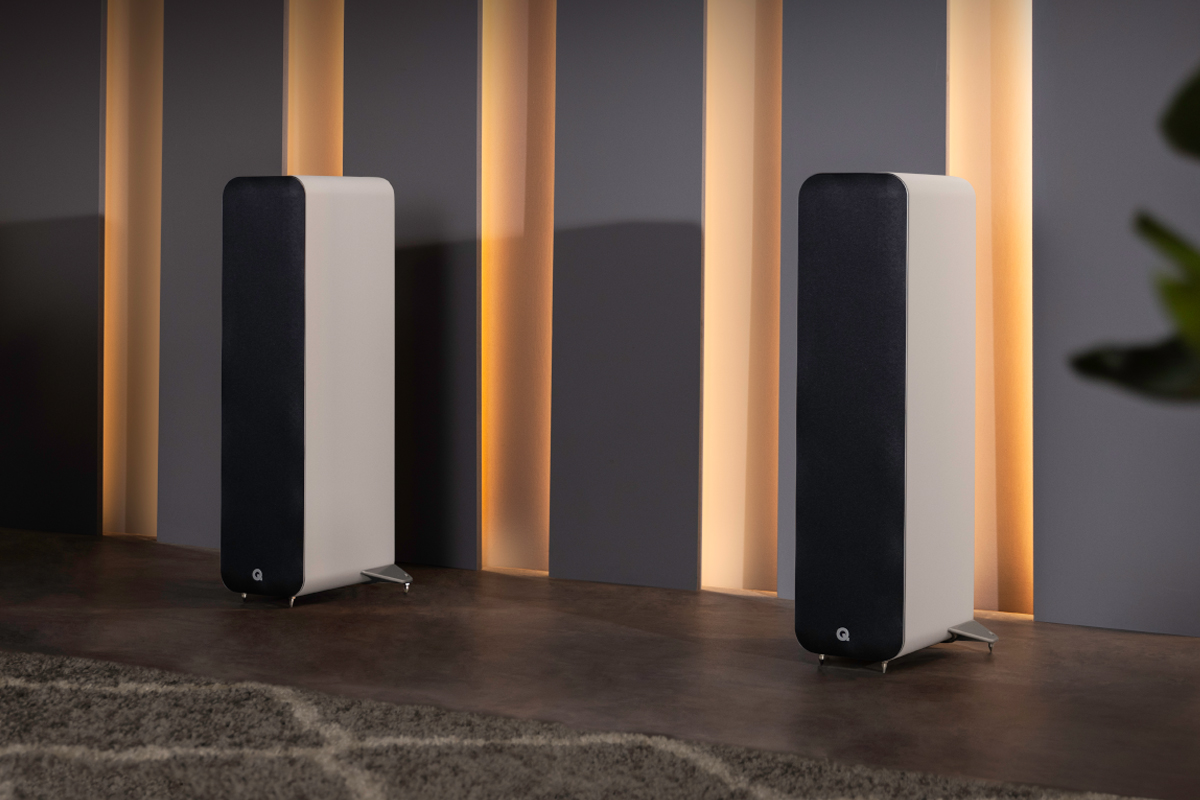When is a speaker more than a speaker? When it’s a system. That is precisely what UK-based Q Acoustics is offering with its M40 HD: an all-in-one music system—just add a source and start playing. Priced at $999 (all prices in USD), the M40 HD is a follow-up to the bookshelf-size M20 HD system ($499), which Kurt Wetzel reviewed for Simplifi in June 2022. But the M40 HD speakers are floorstanders that each have two mid/bass drivers; the M20 HD speakers have one. That, and their greater output power, enable them to play louder and deeper than the M20 HD speakers. For floorstanding speakers, the M40s have a relatively small footprint, which listeners with limited space or a preference for unobtrusive designs are sure to appreciate.
Cabinet design
The M40 HD system comprises a primary speaker, which contains the amplifier and other electronics, and a secondary speaker, which is of a conventional passive design. Each speaker, when fitted with its spikes and wide, rear stabilizers, measures 28″H × 10″W × 11.7″D—“micro-towers,” Q Acoustics calls them. Excluding the stabilizers, the M40 HD enclosures are only 6.7″ wide and look svelte and stylish. Three finishes are available: black, white, and walnut. The sample pair Q Acoustics supplied was the black version.
The M40 HD is a two-way, three-driver, rear-ported design. Each enclosure holds a 0.9″ fabric-dome tweeter mounted above two 5″ mid/bass drivers. Crossover frequency is 2.5kHz. Q Acoustics claims its Continuous Curved Cone (C3) driver design combines the bass performance of a straight cone with the high/midrange control of a flared cone. Specified frequency response is 38Hz–22kHz (-6dB).
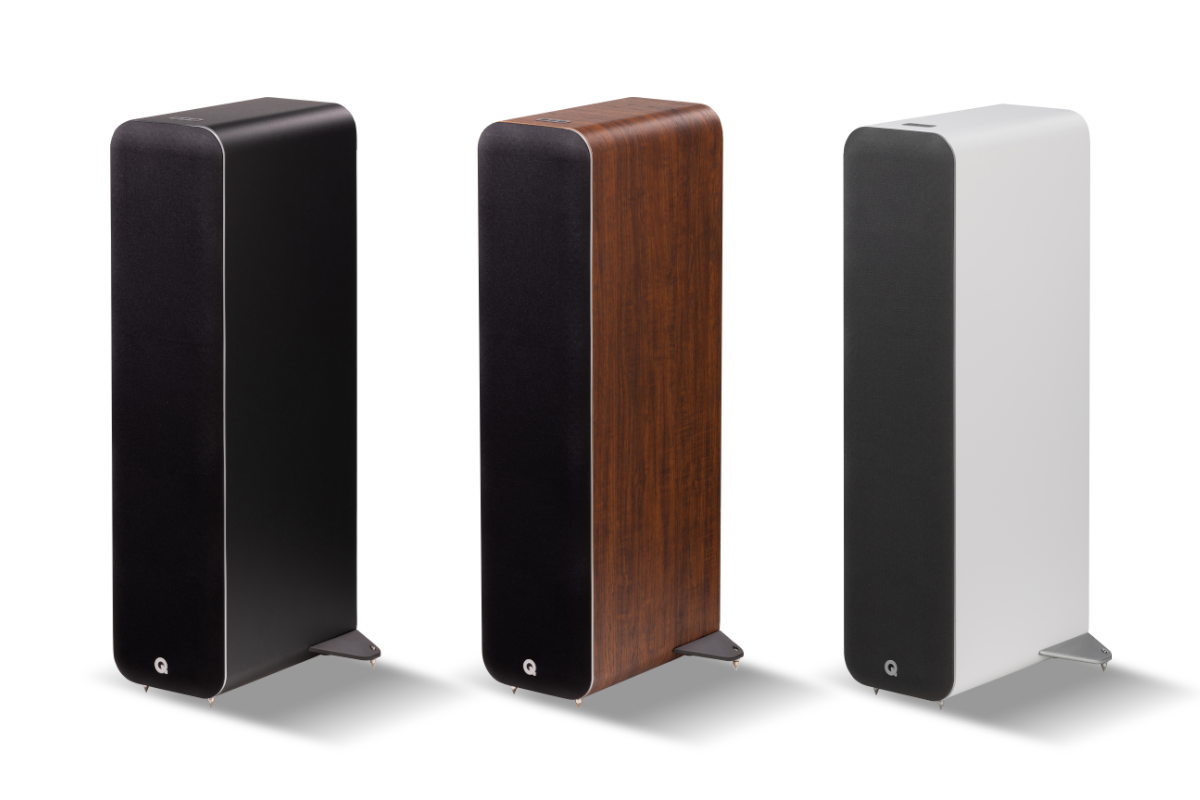
The vinyl-wrapped MDF enclosures incorporate Q Acoustics’ Point to Point (P2P) bracing system, which suppresses cabinet vibration, and its proprietary Helmholtz Pressure Equalizer (HPE) technology, which reduces internal standing waves. The tweeter is decoupled from the enclosure to shield it from cabinet vibrations. As with the M20 HD speakers, the grilles of the M40 HD’s are permanently affixed to the baffle, which allows for minimal grille structure and gives the speakers a sleek appearance.
Near the bottom of the rear panel on each speaker is a large bass port. Q Acoustics supplies two foam bungs that can be inserted into these ports to prevent boominess and improve tonal balance when the speakers are close to walls.
Connections
The primary speaker contains the two-channel class-D amplifier that powers both speakers. Continuous power is rated at 50Wpc, peak power at 100Wpc. Q Acoustics supplies a 4m (13.1′) stripped, tinned speaker wire to carry speaker-level audio from the primary to the secondary speaker. The primary speaker also contains all the input and output connectors as well as a Bluetooth 5.0 receiver that supports the SBC, AAC, aptX, aptX HD, and aptX Low Latency codecs.
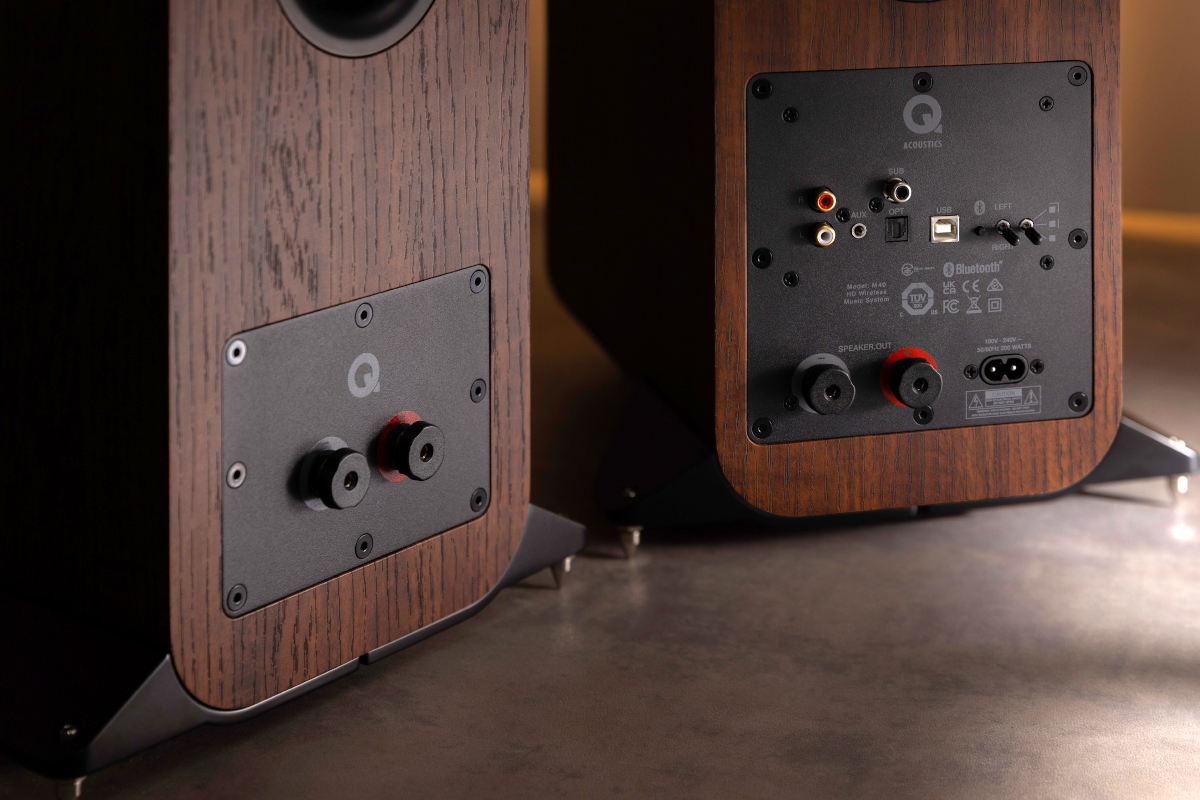
Two line-level analog inputs are available: a pair of RCA jacks and a 3.5mm stereo mini jack. Although the manual refers to the RCA inputs as “analogue phono,” the M40 HD does not have a built-in phono stage. If you want to play vinyl through the M40 HD, you’ll need to use an external phono preamp or a ’table with a built-in phono stage. Also available is an optical S/PDIF (TosLink) input for connecting a digital source, such as a disc player, game console, or an HDTV. A USB Type-B port allows connection to a computer. The maximum resolution of the two digital inputs is 24-bit/192kHz.
Next to the USB port is a two-position switch that assigns to the primary speaker either the left-channel or right-channel audio. This lets you place the primary speaker near the source components, where shorter cables can be used. Not many powered speaker systems offer this useful feature. Right next to this switch is a three-position EQ switch that informs the system whether the speakers are in the open, near a wall, or in a corner, so that its DSP engine can make the proper adjustments for optimal sound.
The subwoofer jack outputs a summed mono signal low-pass filtered at 330Hz.
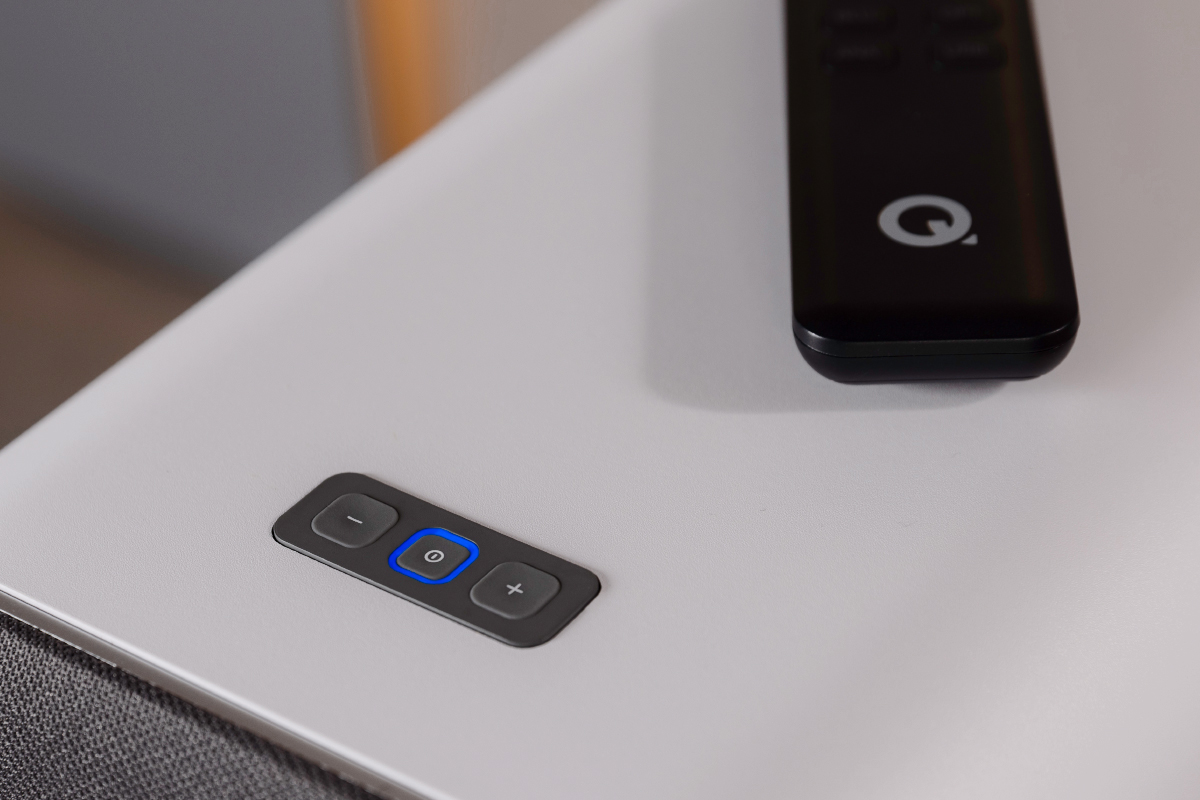
Three buttons are found atop the primary speaker: a power button, also used for Bluetooth pairing and source selection, and a volume-adjustment button on each side. The supplied remote control has power, mute, and pause buttons; volume and skip rockers; and source keys. (The pause and skip functions are available with USB and Bluetooth sources only.)
Setup
Q Acoustics specifies the M40 HD’s primary speaker at 27.3 pounds and the secondary speaker at 26 pounds. I knew that, but when my review sample arrived, as I pulled the two boxes into my living room, I was still surprised by how heavy they were for their size. I was less surprised once I unpacked the two speakers: their robust build and rigidity were immediately apparent.
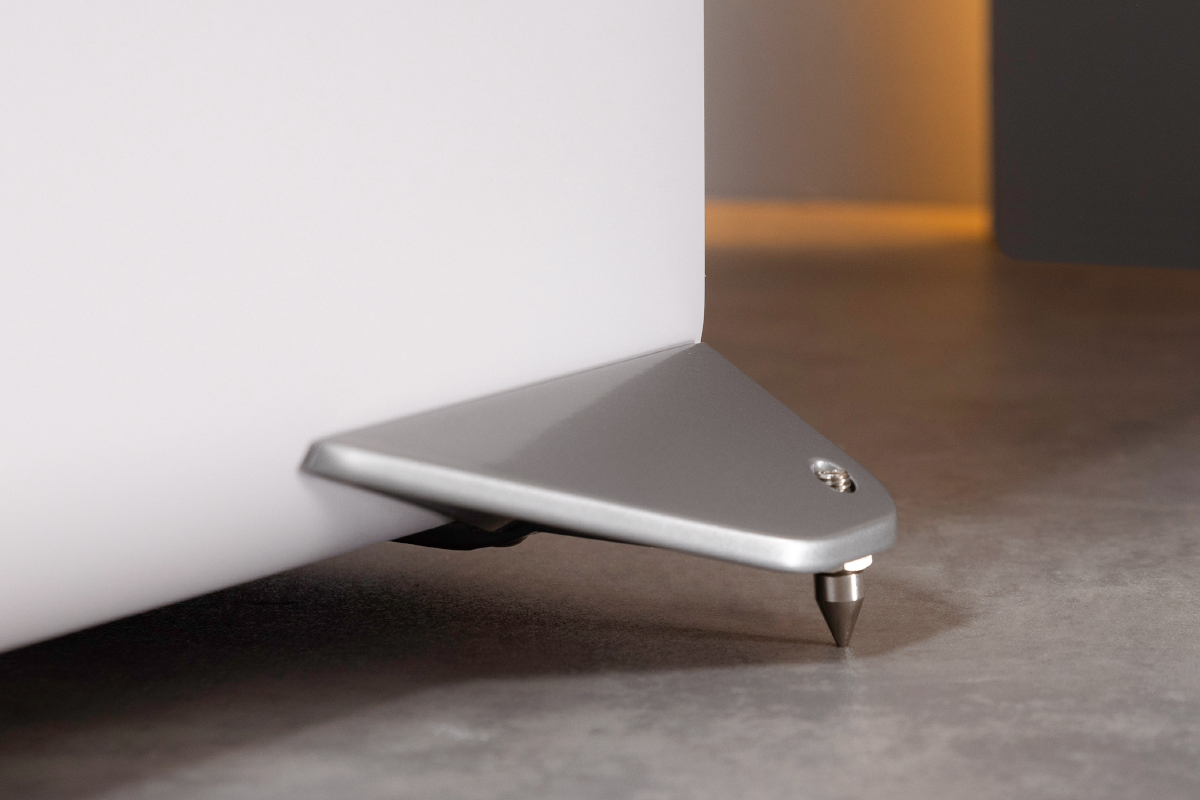
The M40 speakers require some assembly before use, but the steps are laid out clearly in the supplied owner’s manual. Each speaker is supplied with two rear stabilizers, four spike screws, and four spike covers. It’s a simple affair to attach the stabilizers and adjust the height of the spikes as needed with the supplied Allen key. With the stabilizers mounted and the spikes set and secure, the speakers are ready for audio.
Setting up the M40 HD was dead easy. After I powered up the primary speaker, the multi-functional power button on the top was lit red, indicating that the system was in standby mode. When I selected Bluetooth on the remote, the button turned blue. A quick Bluetooth scan on my Samsung Galaxy A32 5G smartphone discovered the M40 HD as a pairing option. I was playing music just seconds later.
In addition to streaming music via Bluetooth from the Qobuz app on my Galaxy phone, I played music from my Dell desktop computer, which I connected to the M40 HD’s USB input.
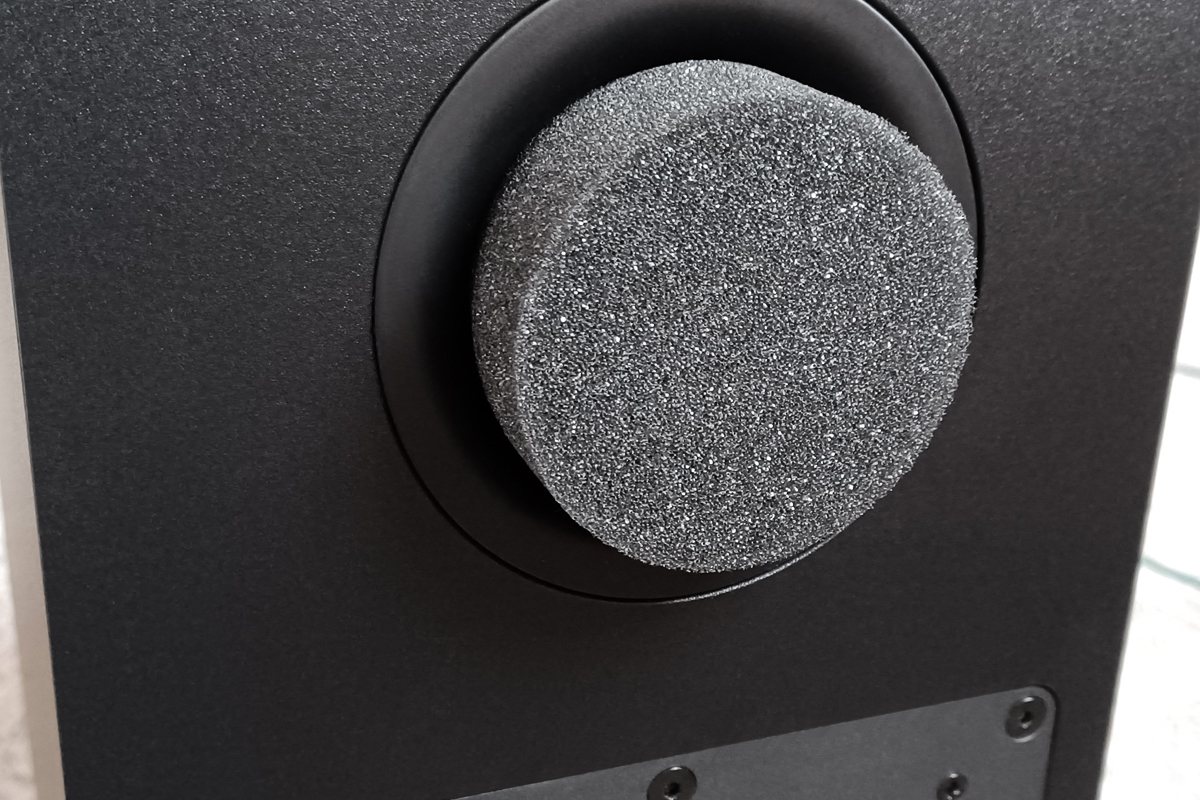
My listening room is 14′W × 16′D. The speakers were positioned 6′ away from me, 5′ apart with a slight toe-in. Being a fair distance from walls—30″ from the front wall and 44″ from the side walls—bloated bass was not likely to be a problem, so I set the EQ switch to the top (free space) position, which allows for full bass output. This setting worked well with every type of music I played. I found that placing the bungs in the ports improved bass definition appreciably.
Listening
With my PC as the primary music source, the M40 HD consistently delivered articulate, punchy, satisfying sound, and had greater bass presence than I had anticipated.
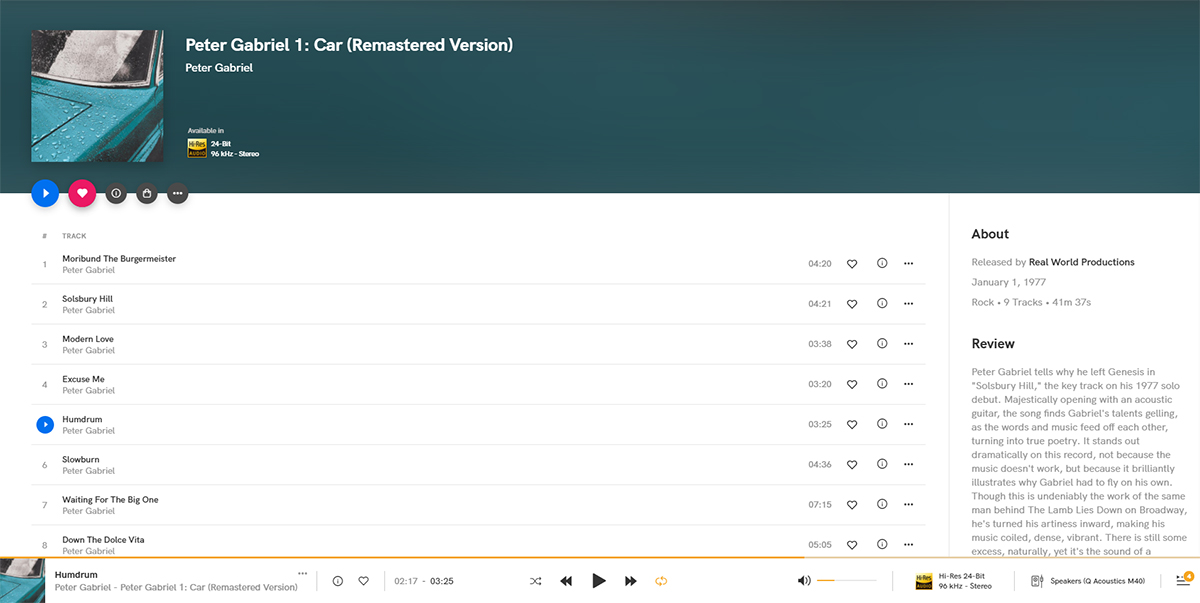
Peter Gabriel’s “Humdrum,” from his 1978 solo debut album, Peter Gabriel 1: Car (24-bit/96kHz FLAC, Real World Productions / Qobuz), covers a lot of musical ground. The song opens with a quiet vocal passage, with just a keyboard accompaniment. It continues with an upbeat, lively section and ends with a floating, atmospheric outro. The M40 HD system created a broad, deep soundstage and kept it up throughout the track. Gabriel’s vocals were immediate and had natural sustain, as did his keyboard. Percussion sounded natural, too, especially the cymbals, which had convincing metallic sheen. At the end, as the song swells with orchestration, imaging became a bit vague, but I could still home in on the piano in that wall of sound as it carried the last section to its conclusion. The M40s kept instruments in their place in this challenging mix.
Richard Thompson’s latest release, Ship to Shore (24/88.2 FLAC, New West Records / Qobuz), features a stunning set of songs and some great guitar playing. “The Fear Never Leaves You” is a haunting tune about never-ending nightmares. Droning drum rhythm, mournful background vocals, and minor-key string bends enshroud this song with a foreboding atmosphere. From the opening verse, the sound of Thompson’s voice and breath is fully present in the mix. It’s as if he’s talking directly to the listener. At the three-minute mark, Thompson’s voice rises briefly and quivers as though truly terrified, an articulation laden with emotion that the M40s carried through unabated. In such moments, when vocals are delivered with enough depth and precision to have a commanding presence and backing instruments seem to fade away, it’s easy to become deeply involved in the music. The M40 system’s impressive imaging and soundstage further deepened my engagement. Moments later, it was the silvery sound of Thompson’s guitar that was showcased, as he plays a plaintive, pedal-steel-like bend that slowly dissipates into single notes.
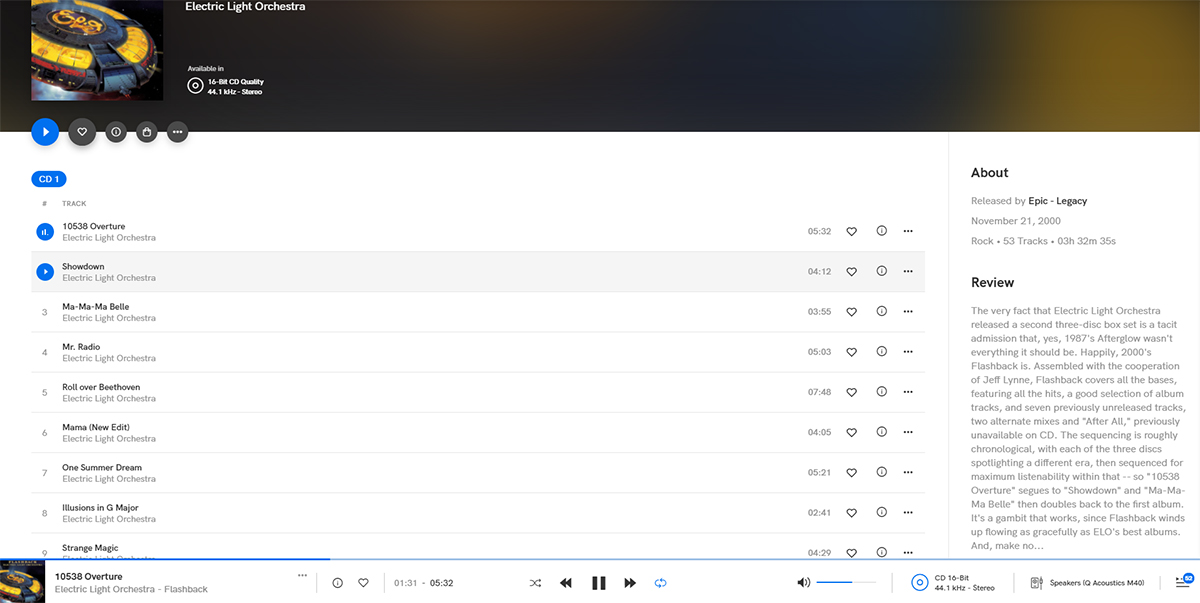
There’s no denying that the contribution to popular music of Jeff Lynne and his band, Electric Light Orchestra, particularly in the halcyon days of the 1970s, has been substantial. The three-disc, 53-song compilation Flashback (16/44.1 FLAC, Epic Records / Qobuz) is an excellent entry point into the British band’s music. As much as I love Lynne’s tunes, I’ve always found his recordings to be a strange combination of mellifluous vocals with desert-dry drums. But the M40 speakers did a great job of revealing the detail in Lynne’s remarkable arrangements without sounding cold or clinical.
On the towering “10538 Overture,” Roy Wood’s aggressive, sawlike cello playing sizzled with energy. But as well as the cello’s stentorian, rich voice—it often sounded like two cellos were playing—I could also hear the sound of the bow contacting the strings. On the fanciful song “Eldorado,” when Lynne opens the second verse, “The painted ladies of the Avalon,” the last word was sustained as a clear and distinct echo for about two seconds, much longer than on some other systems I’ve heard.
Moving from prog rock to the neoclassical, I then played Sergei Prokofiev’s Piano Concerto No. 3, performed by the late American pianist Julius Katchen and the London Symphony Orchestra under the late Hungarian conductor István Kertész. This is one of the many gems found on the 12-CD set Istvan Kertesz: The London Years (16/44.1 FLAC, Decca Records / Qobuz). Katchen’s performance in this recording, from the lighthearted romps to the feverish flourishes, somehow brings out the harmonic richness of his instrument, which the M40 HD system conveyed fully. In the first movement, near the seven-minute mark, a flurry of high-register, alabastrine arpeggios cascades down into a punctuated phrase deep in the bass register. Similar transitions pervade this work, and the stark contrast between the high and low registers was striking through the M40 HD.
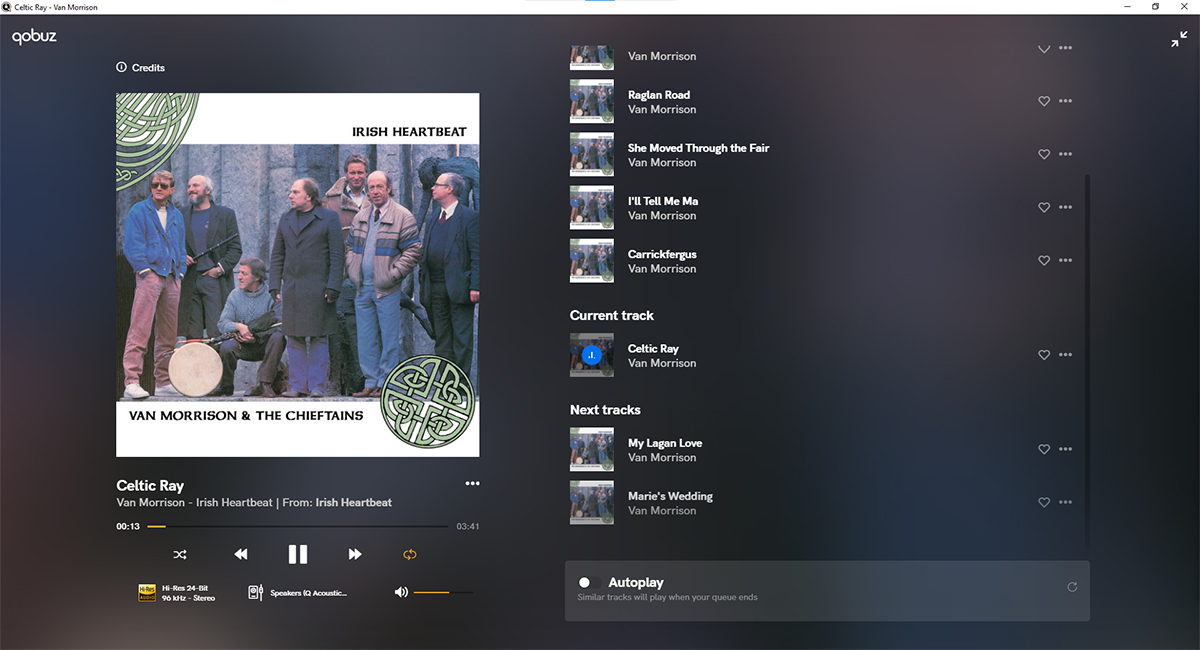
Van Morrison & The Chieftains’ remake of Morrison’s “Celtic Ray,” from the 1988 album Irish Heartbeat (24/96 FLAC, Legacy Recordings / Qobuz), features a bevy of instruments, including tin whistle, fiddle, bodhrán, fretless bass, and harp. There’s a lot going on there, but the M40 speakers were able to render these instruments distinctly and impartially on a wide, deep soundstage. The natural reverb of the bass strings kept in proper balance with the delicate arpeggios of Derek Bell’s harp and Paddy Maloney’s pining whistle lines.
Weather Report’s “Tears,” from the band’s 1971 eponymous album (16/44.1 FLAC, Columbia Records / Qobuz), is a moody jazz-fusion masterpiece. Wayne Shorter’s saxophone, at the fore, intermingles with Joe Zawinul’s electric piano, while Miroslav Vitouš’s rumbling bass, Alphonze Mouzon’s spirited drums, and Airto Moreira’s percussion gizmos send sparks flying all around. The M40s kept everything together. One aspect of the M40s’ presentation that stood out in particular was the fast and dramatic attack transients of the drums, cymbals, and other percussive instruments and the well-defined decay transients that followed.

I used the M40 HD’s USB Audio input for most of my critical listening to take advantage of the high-resolution recordings on Qobuz. But I didn’t feel cheated listening via Bluetooth. The title track of Bachman-Turner Overdrive’s 1974 album Not Fragile (16/44.1 FLAC, Mercury Records / Qobuz) is arguably the most powerful and aggressive song in the group’s discography. C. F. Turner’s bass guitar sounds like a mastodon plodding across the Pliocene landscape while Randy Bachman’s six-string guitar doubles the insistent riff and Robbie Bachman’s drums deliver a powerful beat. As I listened, streaming the tune from my phone, I thought, this is what a Bluetooth speaker should sound like! There was plenty of oomph and swagger here and good instrument separation on a wide soundstage. Given that my Galaxy A32 smartphone does not support any of the advanced Bluetooth codecs—the tune was streamed using the base SBC codec—I did not expect sound quality and presentation to be this good.
Comparisons and conclusion
I don’t own floorstanding speakers, and I didn’t have any powered or active speakers on hand to use for comparison. But as a system that requires nothing more than a source, I could compare it with my own system: a pair of Human Model 81 standmount speakers ($658/pair) driven by a Yamaha A-S801 integrated amplifier ($899.95). The Yamaha amplifier is rated at 100Wpc into 8 ohms or a minimum of 120Wpc into 6 ohms. The Model 81 is a two-way, 6-ohm acoustic-suspension design with an 8″ midrange-bass driver and a 1″ concave aluminum-dome tweeter. For a bookshelf speaker, it’s on the large side: 18.25″H × 11.5″W × 7.5″D. Specified frequency response is 41Hz–26kHz, not much different from that of the M40 HD.
To compare the two systems, I chose Mastodon’s “The Sparrow,” from the band’s 2011 release, The Hunter (24/48 FLAC, Reprise Records / Qobuz), streamed via USB Audio. This track has a dense arrangement of layers of guitars and vocals that jump in and out of the mix. I found that the Yamaha-Human combo etched out more bass than the M40 HD system did. On the other extreme, drummer Brann Dailor’s ride cymbal had more presence. Imaging also was slightly better with this combo. But the M40 speakers had the edge with their deeper and more immersive soundstage. The air between and behind the speakers just seemed filled with music, which made the listening experience hugely engaging and enjoyable.
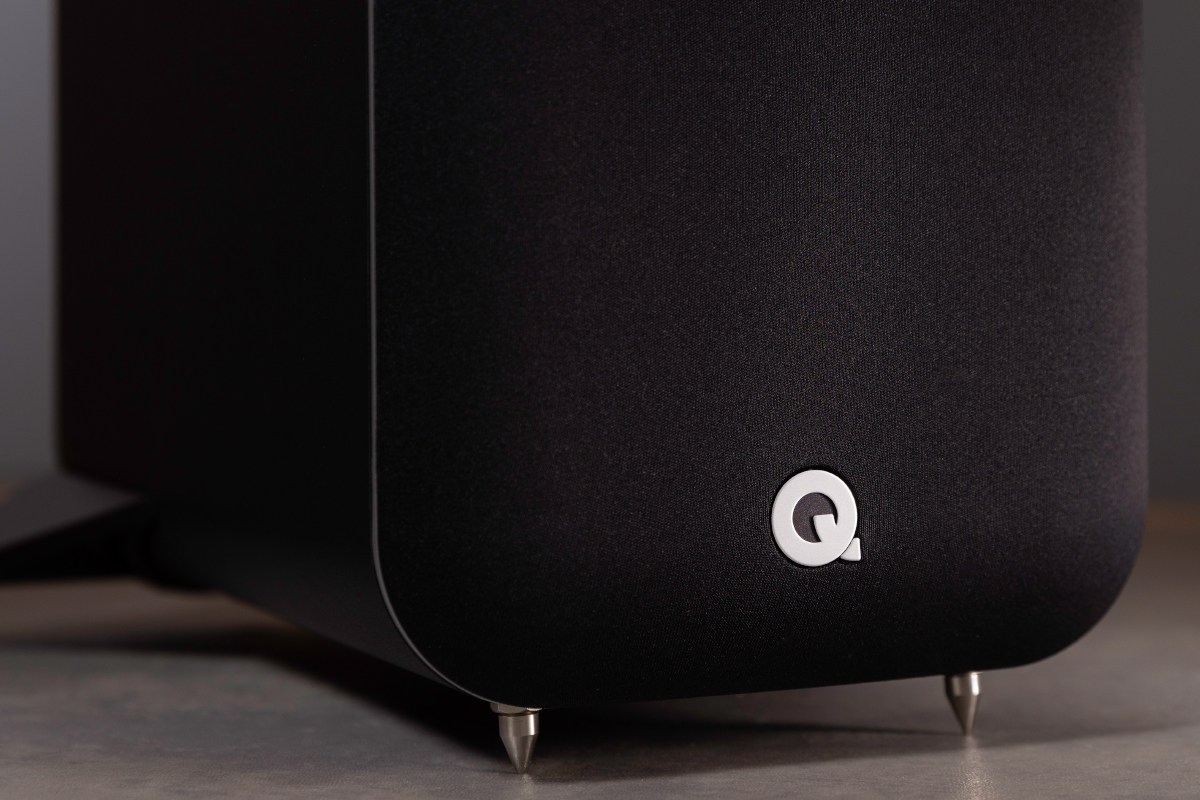
The audio market abounds with powered, wireless bookshelf speakers. But search for a pair of powered, wireless floorstanding speakers, and you will find the Q Acoustics M40 HD system among but a few others at a comparable price. These system are all budget-friendly options as they obviate the need for additional components.
The Q Acoustics M40 HD system is a solid choice for those in search of a compact, simple, yet powerful audio solution. It can handle a variety of music genres with ease and provide a consistently satisfying listening experience. It may not tick every box for every prospective buyer, but with its strong performance and attractive design, it will likely appeal to many. It did to me.
. . . Todd Whitesel
Associated Equipment
- Sources: Samsung Galaxy A32 5G smartphone and Dell Optiplex 7020 desktop PC.
- Passive speakers: Human Speakers Model 81.
- Integrated amplifier: Yamaha A-S801.
- Other: Scosche StrikeLine USB-A to USB-C cable.
Q Acoustics M40 HD Powered Loudspeaker System
Price: $999.
Warranty: One year, parts and labor.
Q Acoustics
Woodside 2
Dunmow Road
Bishops Stortford
Hertfordshire, UK
CM23 5 RG
Website: www.qacoustics.com
Email:





